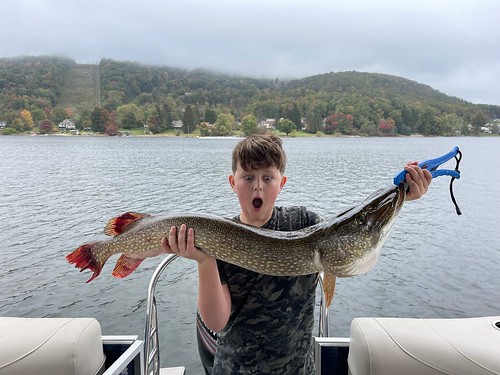
Bergen Kline certainly was thrilled to catch this 41-inch northern pike at Deep Creek Lake recently while fishing with his dad. Photo by Sean Kline
This week is an exciting time for family and friends to be out fishing and enjoying the outdoors, as daytime temperatures become more moderate and a wide variety of fish become more active as waters cool.
Forecast Summary: October 20 – October 26:
It’s another great week to get out and enjoy Maryland’s fall foliage and Bay waters. Conditions will be relatively stable with sunny and calm days — except for a windy Thursday — and cool nights all week. Bay surface water temperatures have dropped to the upper 60s. Improving oxygen and water temperature conditions will continue to provide anglers great opportunities to catch fish in shallower waters and river mouths, ambushing bait moving out of cooler rivers into the warmer main Bay waters. In addition, the traditional places deeper in the water column such as channel edges, underwater points, hard bottom, and drop-offs will also be productive.
With cooling waters, Bay oxygen conditions have greatly improved for gamefish. Suitable oxygen conditions are found at all depths from Susquehanna Flats to Still Pond, at Swan Point, and on the Potomac River from Colonial Beach to Piney Point. Avoid fishing below these depths at the following locations: Bay Bridge to Bloody Point, 20 feet to 35 feet; and Choptank River to Point No Point; 25 feet to the bottom. Conditions can vary daily and within these areas so be sure to check the depth-to-oxygen level online for your specific location.
Expect normal flows for most Maryland rivers and streams. The Susquehanna River is running higher than normal. There will be above average tidal currents all week due to the Oct. 20 full moon.
Expect average clarity for many of the Maryland portions of the Bay and rivers, except the Bush and Back rivers. To see the latest water clarity conditions, check Eyes on the Bay Satellite Maps.
For more detailed and up-to-date fishing conditions in your area of the Bay, check the Maryland DNR website for Click Before You Cast. Get regular updates on Maryland’s waters sent to your inbox with our Eyes on the Bay newsletter. Sign up online.
Upper Chesapeake Bay
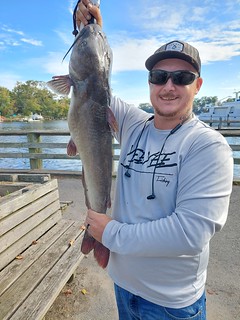
William Anthony caught this large channel catfish while fishing from a dock. Photo courtesy of William Anthony
The lower Susquehanna River and the uppermost sections of the Chesapeake Bay are showing clearer water conditions, which is creating better fishing. The Conowingo Dam has recently begun power generation in the early morning hours, causing higher water at the dam pool.
Striped bass are being caught in the dam pool on topwater lures and paddletails. A fair percentage tend to measure under the 19-inch minimum but offer plenty of catch-and-release action. Anglers are also enjoying good fishing along the edges of the Susquehanna Flats in the morning and evening hours on topwater lures, paddletails, jerkbaits, and soft plastic jigs. Anglers are also live lining small white perch and eels along the channel edges leading away from the mouth of the Susquehanna River.
Blue catfish and flathead catfish are being caught on cut bait in the dam pool, lower Susquehanna River, and Susquehanna Flats channels. A mix of blue and channel catfish are also being caught in the upper Bay and the region’s other tidal rivers. Anglers using eels, spot, and small white perch for live lining in the upper Bay are reporting that catfish are taking baits intended for striped bass. Good places for live lining include Pooles Island and the Key Bridge piers. Catfish offer shorebound anglers plenty of opportunity and can be caught from a variety of locations.
The morning and evening fishing at the mouths of the tidal rivers has been good for a nice grade of striped bass. Most anglers are casting topwater lures and a mix of paddletails, crankbaits, and jerkbaits near shoreline structure. Jigging along channel edges where suspended striped bass can be spotted is also working well for anglers. The Love Point rocks, the mouth of the Magothy River, the sewer pipe just north of the Bay Bridge, and the channel edge at Podickory Point have been especially good places to jig along the bottom.
White perch can be found holding over hard bottom in the lower sections of the region’s tidal rivers and creeks. Using bottom rigs baited with pieces of bloodworm, Fishbites, fresh wild shrimp, or peeler crab is an excellent way to target them. A mix of blue and channel catfish can also be attracted to the baits.
The annual striped bass young of the year survey results have been released for 2021. The survey samples sites in the four spawning rivers at 22 stations and has been done with the same gear and locations since 1954. The striped bass populations in Maryland are also monitored by recreational and commercial intercept surveys and adult spawning stock surveys. To learn more about the striped bass monitoring program, visit the DNR website.
Middle Bay

Herb Floyd recently won the Chesapeake Bay Foundation Rod & Reef Tournament by catching 15 different species on some of the reefs. Herb also caught this nice sea trout. Photo courtesy of Herb Floyd
For the first time this fall, water temperatures in the middle Bay have dipped below 70 degrees, and the tidal rivers are running about 65 degrees. Small baitfish are exiting the tidal rivers and heading down the Bay looking for warmer waters. Schools of striped bass are waiting for them at the mouths of the tidal rivers and the steep edges of the shipping channel. The mouth of the Choptank River, the Severn River, Thomas Point, and Eastern Bay are excellent places to jig for striped bass or to cast into breaking fish. There are quite a few small bluefish mixed in with the striped bass chasing bait, so soft plastics may take a hit and wind up being nipped off. Often the smaller striped bass will be seen on the surface chasing bait, and larger striped bass can be found deep underneath the overhead action.
White perch can still be found in the tidal rivers and creeks but a fair percentage of them are now holding over oyster bottom in the lower sections of the region’s tidal rivers. Fishing a bottom rig baited with pieces of bloodworm, pieces of fresh wild shrimp, peeler crab, or Fishbites are good choices. The artificial reefs in the Chesapeake Bay offer a wide variety of fish species for anglers.
Working bottom rigs around dock piers in deeper waters can still result in some good action; casting beetle spins or small jigs around shoreline structure can work well also. There are plenty of channel catfish in the tidal rivers, and they can be caught on a variety of fresh cut baits, nightcrawlers, and clam snouts. Blue catfish are holding in the lower Choptank River from the Dover Bridge to the Bill Burton Fishing Pier and can be caught on fresh cut menhaden or gizzard shad.
Lower Bay

This fine-looking autumn striped bass fell for a surface popper. Photo by Keith Lockwood
The lower Bay seems to be alive with breaking fish and a wide variety of fishing opportunities. Baitfish in the form of juvenile menhaden and bay anchovies are moving out of the tidal rivers and into the Bay, on their journey into warmer waters. A mix of small to medium-sized bluefish, smaller striped bass, and a few Spanish mackerel are holding near some of the steeper edges of the shipping channel and the channels leading out of the tidal rivers. They are feasting on the baitfish that often drive them to the surface where seagulls help mark the way for anglers.
Coming in on the upwind side of the action, cutting your engine and drifting into the action is the best way to approach when casting into breaking fish. Bolder approaches can often drive the fish down and cause the action to cease. When it seems the fish have driven deeper, all is not lost. It is time to break out the jigs and braided line, drop a line down deep, and begin jigging. Slicks may be spotted and they will also tell of action going on below.
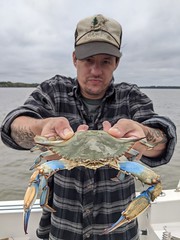
Gary Nasuta holds up a large blue crab for a picture. Photo courtesy of Gary Nasuta
Trolling can be a great option when fishing for a mix of bluefish and striped bass during the fall. When fish are suspended deep, umbrella rigs pulled behind heavy inline weights are a popular way to get down to where the fish are holding. Bucktails, hose lures, and small Drone spoons are good choices for trailers. If trolling in shallower waters at the mouths of the tidal rivers, favored lures are small spoons, swimshads, and bucktails dressed with soft plastics. The shipping channel edges, the channel edge in the lower Potomac River from St. Georges Island south to Piney Point, and the channel leading out of the Patuxent and Nanticoke rivers are great places to check for striped bass.
Casting topwater lures, paddletails, crankbaits, and jerkbaits along likely-looking shoreline structure is a fun and productive way to fish for striped bass. Rock piles, long piers over deep water, and prominent points are all good places to try in the Bay and the lower sections of the tidal rivers. Depths of 8 feet to 12 feet seem to be the sweet spot reported by anglers.
On the eastern side of the Bay, the Hoopers Island cuts and areas under bridges are productive places to work soft plastic jigs along the bottom. Bluefish, speckled trout, and slot-sized red drum can be part of the mix. Some are getting good results drifting baits of soft crab and fresh wild shrimp for speckled trout and red drum, on outgoing tides at the mouths of some of the small creeks draining from the Eastern Shore marshes.
Spot and croaker are becoming mighty scarce in the lower Patuxent River, but there are plenty of white perch holding on oyster bars in the lower Patuxent, St. Mary’s, and Wicomico Rivers. There are reports of small spot being found at the mouth of the Nanticoke River along with a lot of white perch on oyster bottom there.
Cooler water temperatures in the upper reaches of the tidal rivers are forcing blue crabs to descend to the lower sections of the rivers. This is providing some good options for anyone wishing to put together another catch or two of crabs before the waters get too cold. The crabs tend to be deep, often in 10 feet to 15 feet of water, and many of them are quite large. Trotlines and collapsible traps tend to be equally productive. The cownose rays have left for the most part, so razor clams tend to last longer. Chicken necks are also productive.
Freshwater Fishing
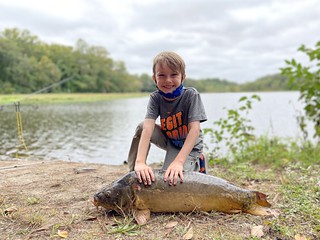
Fhinn Zeender-Lawrence was fishing at Tuckahoe State Park when he caught this large carp. Photo by Nathan Zeender
The trout stocking crews continue with the fall stocking program, delivering fish to trout management waters across the state. The hatcheries are producing excellent trout this season due to plentiful rain and good flows. The brown trout production was noted to be exceptional. Don’t miss getting out to experience the wonderful fall weather and enjoy trout fishing in waters near you. Be sure to check the DNR trout stocking page and the additional links to see where trout are stocked, including areas designated for children and individuals with disabilities.
The upper Potomac River is flowing well with water temperatures in the 60s, and this is a great time to fish for smallmouth bass in the river. Tubes, small craws, small crankbaits. and small swimbaits are all good lures to cast near current breaks, submerged ledges, and boulder pockets.
The fall turnover of Deep Creek Lake is bound to occur in the next week, if it has not happened in the past day or so. The mixing of surface and deeper waters always spurs the fall fisheries into high gear for walleye, smallmouth bass, yellow perch, and northern pike. The walleye and yellow perch can be found along deep grass edges, and walleye will begin to explore rocky shores in the evening hours. Northern pike can often be found at the mouths of various coves, while smallmouth bass are on rocky points.
Water temperatures are just about ideal for largemouth bass. They are comfortable to move about in a variety of water depths, and can actually be found holding in sunny and shallow areas gaining a little warmth – a far cry from the summer pattern of seeking cool shade during the day. Grass beds are diminishing, but there are still plenty to hold largemouth bass and gain their attention looking for baitfish and other food.
Casting buzzbaits over grass is a great way to attract a strike from either a largemouth bass or northern snakehead. Jerkbaits, spinnerbaits, and small lipless crankbaits are good choices for working edges, while stick worms work well in grass mats. Diving crankbaits, craws, and grubs worked near drop-offs and deeper sunken wood are good choices for targeting largemouth bass that are holding deeper.
The fall months can be a very productive time to fish for carp in many of the tidal rivers and impoundments around the state. They offer plenty of fight and excitement for anglers.
At the Smithville Lake boat ramp, a survey crew has completed its work and were expected to dismantle the crane and other equipment Oct. 20. Their work will inhibit fishing near the boat ramp for an additional day.
Fishing for channel catfish and blue catfish is good as they are holding in the tidal rivers. The tidal Potomac above Indian Head, the Patuxent River at Jug Bay, the Choptank River near the Dover Bridge, the Chester River near Crumpton, and the lower Susquehanna River are all good places to target blue catfish. They will also show up in just about every tidal river in the Chesapeake Bay system at any time. Fresh cut menhaden or gizzard shad, nightcrawlers, clam snouts, and chicken liver are all good baits for blue catfish and channel catfish.
Crappie are schooling up and holding in about 10 feet to 15 feet of water near bridge piers, marina docks, and fallen treetops. A slip bobber rigged with a small, live minnow or marabou jig are popular ways to fish for them. The tidal Potomac near the Wilson Bridge and the Fort Washington Marina is a wonderful place to find crappie. The fishing bridge piers at Liberty Reservoir and the many small ponds and lakes that dot the Maryland landscape all hold crappie. Look for deeper water and some kind of structure, such as fallen treetops or sunken wood.
Atlantic Ocean and Coastal Bays
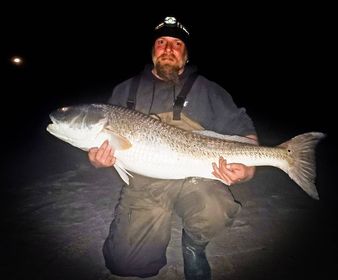
David Moore holds up a whopper of a red drum before releasing it back into the ocean. Photo courtesy of Scott Lenox
The large red drum run that has been keeping catch-and-release surfcasters busy for the past week and a half is showing signs of slowing down, as the main bulk of the fish have moved through the Maryland waters on their way south. Heavy surf fishing gear and large baits of cut menhaden or mullet on a bottom rig has been the most popular way to fish for them.
Those fishing smaller baits of bloodworms, Fishbites, and fresh wild shrimp are catching kingfish and spot. Cut spot will entice small bluefish that are in the surf. Sand fleas are the preferred bait for the few pompano and small black drum that can be found.
Recent winds have stirred up the back bay waters and flounder fishing may slow down a bit until it clears up. Flounder are being caught in the channels leading towards the inlet, along with a few croaker. At the inlet and Route 50 Bridge area, striped bass are being caught along with a few slot-sized red drum and sea trout. Sheepshead and triggerfish can be found near the jetty rocks and bridge piers.
Outside the inlet, fishing for sea bass remains good at the wreck and reef sites and limit catches are not uncommon. Flounder can also be found near the wreck and reef sites. Farther offshore at the canyons the exceptional yellowfin tuna bite continues despite recent rough ocean conditions. Anglers have been chunking at Washington and other canyons, with limit catches of fat yellowfin tuna being brought into the docks. Dolphin and white marlin catches are also reported by those trolling. Deep dropping for tilefish remains strong.
“I get all the truth I need in the newspaper every morning, and every chance I get I go fishing, or swap stories with fishermen, to get the taste of it out of my mouth.” — Ed Zern
Maryland Fishing Report is written and compiled by Keith Lockwood, fisheries biologist with the Maryland Department of Natural Resources.
Click Before You Cast is written by Tidewater Ecosystem Assessment Director Tom Parham.
This report is now available on your Amazon Echo device — just ask Alexa to “open Maryland Fishing Report.”
